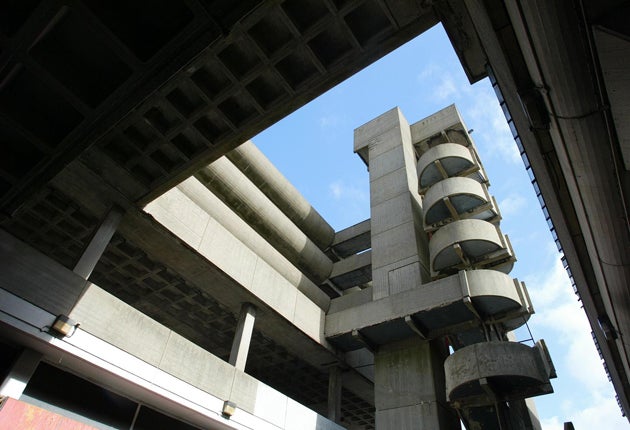Battle to save Britain's Brutalist buildings from the bulldozer
Snub by Culture minister raises fears that another Modernist construction is doomed

They are ugly, they are in your face, and the public often hate them. But the Culture minister Margaret Hodge's refusal to give a Grade II heritage listing to the Brutalist-style Birmingham Central Library – a huge inverted concrete ziggurat built in 1974 – has ignited a dogfight which highlights the bleak outlook for this genre of historic architecture.
The Friends of Birmingham Central Library, supported by the Twentieth Century Society, an action group which fights to save important modernist buildings, have forced the Department for Culture, Media and Sport to re-examine the Culture minister's refusal to give the library a Grade II listing. The prospects are gloomy: the department has just confirmed its refusal to list Preston bus station, another 1970s building with an extraordinary structure.
In London, recently doomed buildings include the Robin Hood Gardens housing estate, the now demolished Milton Court portion of the Barbican, and Hereford Square apartments in Kensington. And one architect, Owen Luder, has had three mega-Brutes consigned to oblivion: the Trinity Square car park in Gateshead which featured in the Get Carter film, the savagely outlandish Derwent Tower – aka the Dunston Rocket – in the same town and the Tricorn Centre in Portsmouth, whose rotting concrete carcass still stands, unwanted by developers seven years after its listing was refused.
In Birmingham, the razing of the Central Library and other buildings on the Paradise Circus site will trigger a £600m scheme by developers.
English Heritage recommended the library be listed Grade II. But the Commission for Architecture and the Built Environment disagreed, and its apparently influential role in Ms Hodge's decision has alarmed Twentieth Century Society director, Catherine Croft. "Cabe does not have any historic building expertise," she said.
She said that the Culture minister had given too much weight to public and commercial opinions.
But even English Heritage and the Twentieth Century Society do not always agree about which Brutalist buildings should be listed, which means developers are finding it easier to get what they want. In some cases, developers present more detailed and persuasive appraisals of the buildings they want to demolish than English Heritage does in defending them. Jon Wright from The Twentieth Century Society claimed this had been the case when developers successfully argued for the de-listing of the Hereford Square apartments.
Meanwhile, there is another Brutalism at work. "Even if the Central Library is listed," said Birmingham City Council spokesman Simon Houltby, "we'll still knock it down. Listing doesn't look at suitability for use. It's just more bureaucratic process to go through." Grade II listings can be ignored on the grounds of the economic or social benefit of redevelopment.
Work has just started on Birmingham's new £193m super-library, a stone's throw from the incredible hulk – Europe's biggest public library – which was designed by John Madin.
Architecture: Beastly buildings
*With its upside-down ziggurat structure, Birmingham Central Library, serves 5,000 visitors a day. There has been a library in Chamberlain Square since 1865; the present structure was opened in 1974. Designed by John Madin, the proposals had it situated amid landscaped gardens but the plans fell through.
*Work started on Preston bus station in the city's centre in 1968, and it opened a year later. Designed by Keith Ingham and Charles Wilson, the station and its unique ribbed structure have been under threat of demolition for more than a decade.
*An example of the "streets in the sky" concept – social housing with wide aerial walkways in long concrete blocks – Robin Hood Gardens, is a 213-flat council-house complex in Poplar, east London. Alison and Peter Smithson designed it in the late 1960s, and work was finished in 1972. The two main structures are made of dour, pre-cast concrete. The complex has been earmarked for demolition as part of a larger regeneration project called Blackwall Reach.
*Named for the poet John Milton, and part of the Barbican in central London, Milton Court was demolished in 2008 to make way for flats and space for the Guildhall School of Music and Drama. Designed by famous modernists Chamberlin, Powell and Bon, it was finished in 1965 and housed a fire station, mortuary and a coroner's court.
*Known as the "Dunston Rocket" because of its shape, Derwent Tower in Dunston, Gateshead, was completed in 1971, designed by Rodney Gordon. The 29-storey building was marked for demolition at the end of last year after years of neglect.
*The site for several key scenes in the 1971 movie Get Carter, the Trinity Square shopping centre's car park in Gateshead, another Rodney Gordon design, was a crumbling cause célèbre for the anti-Brutalist movement. It was opened in 1969 but weathered badly, before finally coming down last year.
*This Portsmouth shopping and apartment complex was named the Tricorn Centre because, from the air, it looked like the 18th-century hat. Opened in 1966 for £2m in an attempt to revitalise the city, the hoped-for premium stores never moved in. Voted the UK's most hated building in 2001 by Radio 4 listeners, it was taken down in 2004.
Subscribe to Independent Premium to bookmark this article
Want to bookmark your favourite articles and stories to read or reference later? Start your Independent Premium subscription today.

Join our commenting forum
Join thought-provoking conversations, follow other Independent readers and see their replies